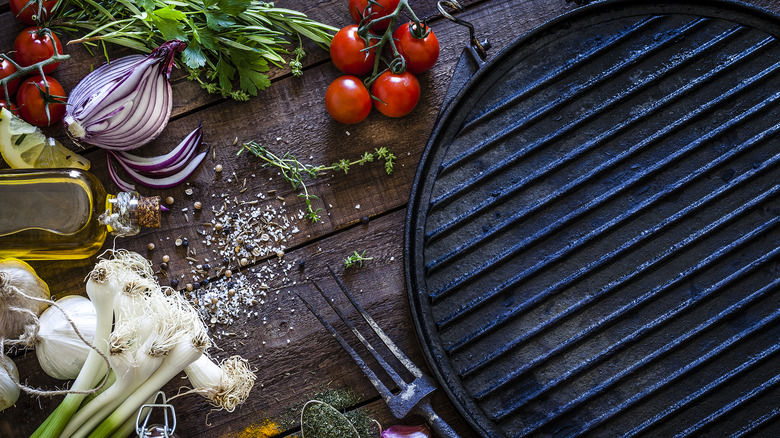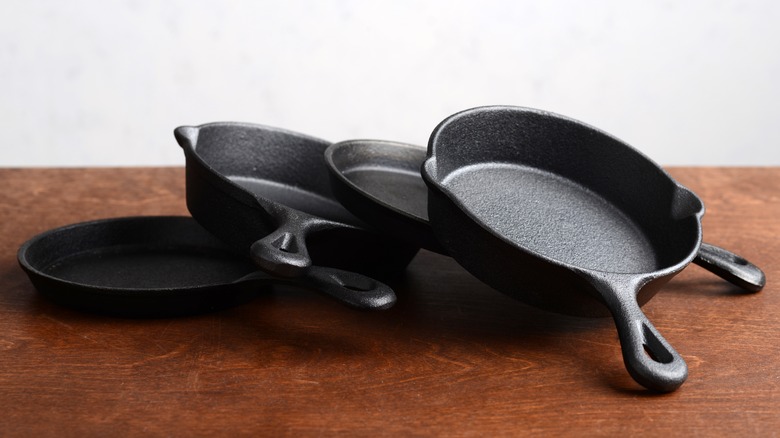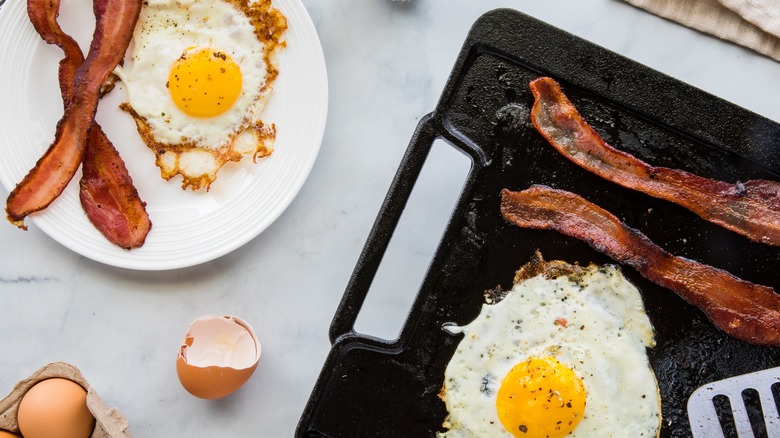Skillet Vs Griddle: What's The Difference?
Just as with carpenters, gardeners, or sculptors, a wise cook possesses the exact right tools to do the job. Perhaps the most important of these fall under the broad category of pots and pans. After all, stovetops and ovens will always provide heat, and refrigerators and freezers will always cool. But the right pot or pan goes a long way toward the quality of the dish. We've already discussed the difference between a skillet and a pan. Now let's examine the difference between a skillet and a griddle. Both have handles, a flat bottom, and can be made in a variety of materials. Put simply, the difference between skillets and griddles has primarily to do with various cooking techniques and heat applications.
Griddles are great for foods which need to be cooked over highish heat and flipped, like pancakes, fried eggs, and bacon, while skillets can used to cook food more slowly (like braising, because they come with a lid), or liquid-retaining high-heat processes like frying. It's easier to flip pancakes when your spatula has more access to the cooking surface. Therefore, griddles either have shallow sides or none at all. Conversely, skillets have comparatively higher sides which tend to be sloped — which, with respect to braising, works both for high-heat searing as well as the addition of a cooking liquid.
Skillets: an absolute kitchen all-rounder
Because of its incredible versatility, no kitchen is complete without a good skillet. With a wider base than typical pans, a skillet shines in stir-frying and deep-frying applications. (There's nothing stopping you from using one to cook steaks or fry eggs, either!) The big thing you want from a skillet is heat retention.
Because of this — and unlike most woks or sauté pans — great skillets tend to be made from more robust material like cast iron. While it's true that this metal takes longer than usual to get hot, once it's up to temperature it will retain heat longer than most anything else, reducing the need for direct, high heat and providing a consistently hot cooking surface or a more stable fry-oil temperature. Going in the other direction, a covered cast iron skillet set over low heat will envelop a braising liquid with just the right amount of warmth to maintain a good simmer without destructive boiling.
Griddle me this
Griddles are also often (but not exclusively) made from cast iron, and are available in nonstick, ceramic, aluminum, and steel. Old-school griddle pans are round, can fit over a single burner, and tend to resemble a frying pan without the sides. Many griddles are much bigger rectangular affairs designed to fit over two burners, ready to crank out a family-sized batch of French toast or grilled cheese sandwiches. Quite a few griddle surfaces feature raised ridges, ideal for keeping your bacon from marinating in its rendered fat. Some are even electric and can be used on a countertop, then disassembled for storage. (Just be sure to avoid making these 12 mistakes on your electric griddle.)
So, what can you make on a griddle? Lots of things: The British use them for making scones and bread. They're ideal for Mexican fajitas and tortillas. Use them as a go-to for flash-seared burgers and steaks. Also, a good griddle is basically a breakfast machine, able to handily crank out eggs, bacon, pancakes, French toast, and hash browns — and this alone might be its greatest selling point.


